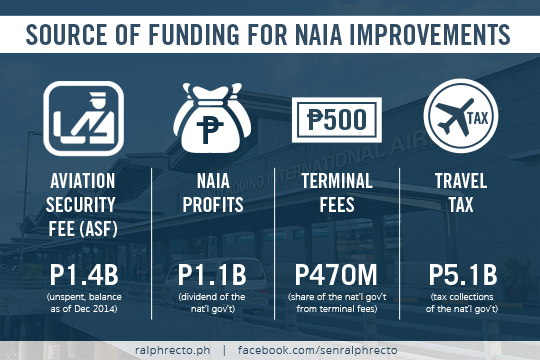Use terminal fees, NAIA profits, travel tax for more CCTVs, better facilities
Every Ninoy Aquino International Airport (NAIA) user pays an Aviation Security Fee (ASF). It is P60 for international passengers and P15 for those who will take domestic flights. The amount is tucked into the Terminal Fee, which is P550 for international passengers and P200 for domestic ticket holders.
ASF has an unspent balance of P1.4 billion as of December 31, 2014. This year at least P626 million in ASF will be collected, and almost the same amount will be spent. Clearly, the ASF can fund the purchase of equipment that can bolster security, including CCTVs that can detect banned items in luggage and deter the planting of bullets in them. Include GoPro cameras and X-ray machines or programs which can store and print captured images so that when a bullet is a detected there is a photographic record to back up the claim.
NAIA is a government profit center. The Manila International Airport Authority (MIAA) posted gross revenues of P8.7 billion in 2013, and net profit before tax of P3.9 billion.
As a government corporation, it remits profits to the Treasury. Last year, according to 2016 budget documents, it turned over P1.1 billion as the dividend of the national government from its income.
Again, this can be a source of funding for NAIA improvements. There can be two mechanisms for this: Either the MIAA can retain a portion or all of what it is supposed to remit, or the government can plow it back. For 2016, the government can observe a moratorium from enjoying NAIA profits and instead reinvest the same for facility improvements, including the one-stop, multi-agency government assistance and complaints to be operated by the Presidential Action Center.
National government earns from the NAIA Terminal Fee. In the case of the P550 that every international passenger coughs up, P100 goes to the Treasury. (P60 is in ASF and P390 for airport operations, maintenance and salaries) Next year, the government expects to receive P470 million as share from the terminal fees paid not just by NAIA users but by outbound air travellers nationwide. Again, this can either be retained in part or in whole by the collecting unit or plowed back to them entirely. For example, the government can observe a two-year abstinence from enjoying the katas of terminal fees so the same can be spent for projects that will bring more comfort to airport users.
Use the Travel Tax for NAIA improvement. The government will earn P5.1 billion from Travel Tax collections this year, mostly from NAIA outbound passengers. NAIA is a major collection point of this tax. This tax is either included in the ticket fare or paid before check-in at the Tourism Infrastructure and Enterprise Zone Authority kiosk. Rates range from P2,700 for a first class passenger; P1,620 for an economy seat; to P300 for an OFW dependent. Also, a significant portion of the Civil Aviation Authority of the Philippines’ (CAAP) projected P5.4 billion gross income this year would come from NAIA flight operations.
To its credit, government had spent P1.3 billion for NAIA 1’s makeover. Obviously, there remains a big deficit in the comfort facilities of its four terminals. Government should sustain NAIA’s renovation.
RELATED ARTICLES:
-
29 AUG 2018: With NAIA past peak capacity, gov’t must announce ETA of new airport
-
10 AUG 2017: Use NBI, intel fund, NAIA big income to smash Maleta Gang
-
14 JUL 2016: Recto: Flying commercial gives Pres. Digong opportunity to monitor NAIA’s improvement
-
04 APR 2016: Blackout unacceptable, NAIA in the black with P3B profit
-
04 NOV 2015: No penalty in carrying amulets made from ammo shell – Recto
-
30 OCT 2015: Recto seeks Palace detachment in NAIA via ‘presidential action desk’
-
28 OCT 2015: Focus on 1.9 M loose guns, not on ‘bullets’ in OFW luggage – Recto
-
02 OCT 2015: Display in NAIA ‘performance guarantees’ of agencies
-
26 SEP 2015: Planting ammo carries life in jail penalty, time for Senate to probe many airport scams


